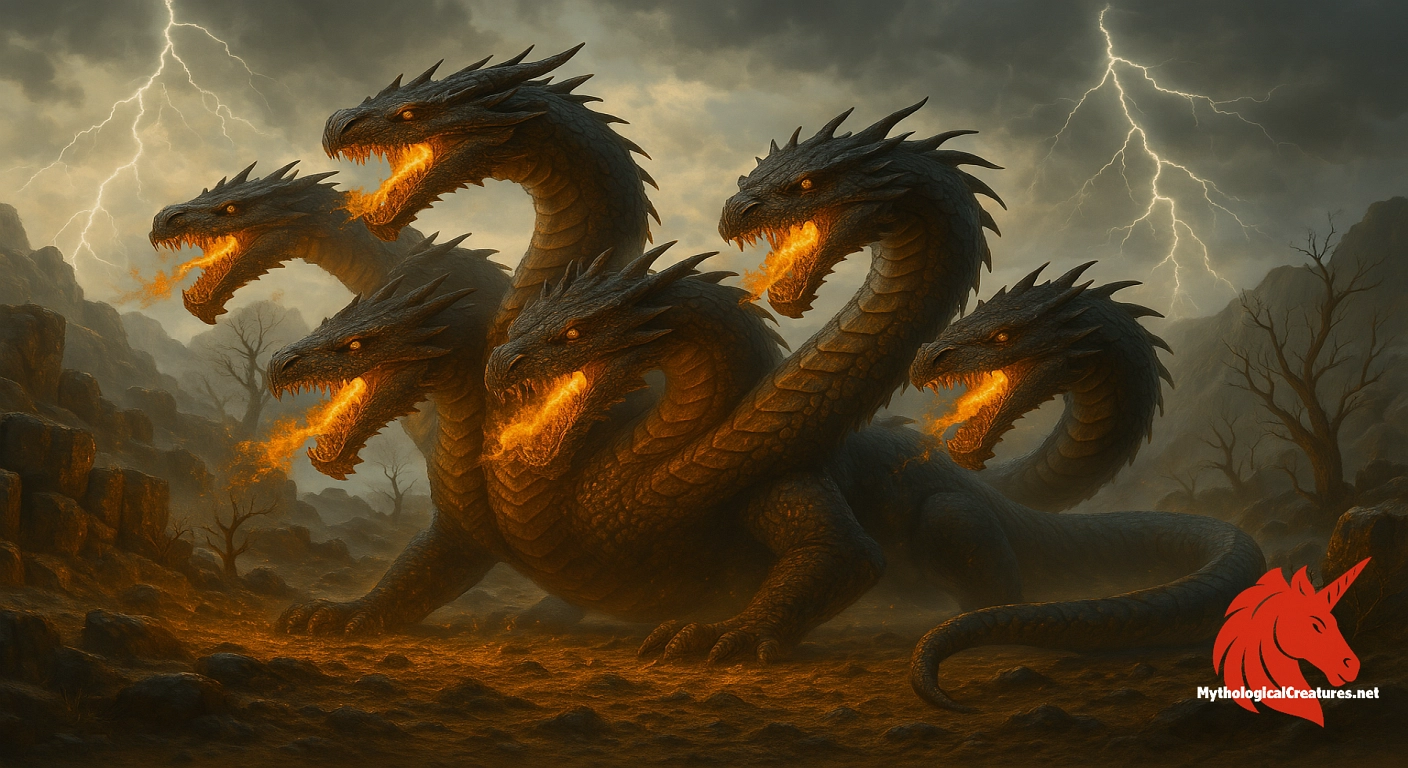Stihi: Stihi is a fearsome, fire-breathing storm demon from Albanian mythology.

Stihi
Stihi - Represents the destructive and unpredictable forces of nature in Albanian folklore
Origins & First Encounters
Stihi is a legendary fire-breathing storm demon deeply embedded in Albanian mythology, renowned for its volatile presence and elemental might. It is believed to have emerged from the raw powers of nature, embodying both the destructive and transformative forces of fire and wind. Ancient lore paints this creature as a formidable figure, with early attestations found in the oral traditions of mountainous communities. Its origins appear intertwined with humanity’s early attempts to explain tempestuous weather and natural disasters. Over centuries, the myth of Stihi has been nurtured by storytellers who weave its image into the fabric of local cultural identity. The creature is portrayed not merely as an agent of chaos, but also as an enigmatic symbol of nature’s unpredictable temperament. Communities have passed down tales of Stihi through generations, often recounting dramatic encounters during violent storms. In these narratives, the demon’s fire is as much a metaphor for regeneration as it is for destruction. Its reputation has grown through numerous renditions into a figure that challenges the boundaries between mortal realms and supernatural domains. The enduring allure of Stihi continues to spark fascination and serves as a constant reminder of the awe-inspiring power of the natural world.
Source Texts & Tale Variants
The story of Stihi is primarily preserved through vibrant oral traditions rather than a singular ancient manuscript. Early folkloric accounts have been transmitted orally by elders in remote Albanian villages, ensuring the demon’s presence in local narrative cycles. In various medieval ballads and regional chronicles, scattered allusions to a fiery storm demon serve to reinforce its status within the mythic canon. Some storytellers have recorded variations that highlight Stihi’s dual role as both a harbinger of doom and an enigmatic protector of natural order. These divergent accounts have been passed down through generations, each adapting the demon’s attributes to reflect social and environmental contexts. Collections of folklore occasionally capture dramatic descriptions of the creature emerging amid violent weather events, linking it to unexplained natural phenomena. Over time, as cultural custodians modified the tale, the creature’s portrayal evolved into a complex symbol rooted in both awe and caution. Local festivals and community recountings have further cemented its place as a central figure in the narrative of natural forces. Although definitive primary texts are sparse, a rich tapestry of storytelling ensures that Stihi remains a potent mythological presence. The enduring nature of these oral accounts demonstrates the dynamic interplay between tradition and imagination in preserving cultural heritage.
Form & Powers
Stihi is depicted as a visually arresting and mutable entity that embodies the tumult of a storm and the ferocity of fire. Descriptions often portray the demon as possessing a sinuous, serpentine form interwoven with billowing clouds and glowing embers. Its eyes are said to burn with an inner light, casting an eerie radiance that hints at the fury within. Brimstone-like scales, reminiscent of molten rock, cover parts of its body, while jagged horns or spines emerge to accentuate its demonic visage. Some versions of the myth describe massive, clawed limbs capable of unleashing destructive force, while others suggest a more shadowy, almost ethereal presence that defies precise measurement. The creature’s breath, a searing plume of fire, is as much a weapon as it is a symbol of nature’s destructive potential. Variations in length and bulk are noted across different narratives, with some depictions lending the entity the form of an enormous beast and others a more elusive, spectral figure. In artistic renderings, Stihi is frequently shown with wing-like appendages that evoke both the imagery of bats and the grandeur of mythic dragons. This amalgamation of features serves to create an unforgettable silhouette that is both terrifying and awe-inspiring. Each detail, from the incandescent glow of its skin to the tumultuous aura surrounding it, reinforces Stihi’s role as an elemental force beyond human control.
Regional Faces
Across the varied landscapes of Albania and neighbouring regions, the interpretation of Stihi shifts to mirror local environmental and cultural nuances. In the rugged northern mountains, the demon is often depicted as a tempest incarnate, its fiery nature tightly interwoven with the unpredictable weather and fierce natural elements. Southern folk narratives sometimes imbue Stihi with a spiritual dimension, portraying the creature as a mysterious guardian who both punishes and protects. Rural communities frequently recount tales of sudden storms and wildfires attributed to the wrath of this spectral being, reflecting the raw power of the natural world in their local climate. In some locales, the demon is even seen as a double-edged force—capable of wreaking havoc on the unprepared while occasionally offering a portent of renewal and rebirth. Local artists have adapted Stihi’s image to capture the essence of regional storms, creating variations that highlight either its violent bursts or its more enigmatic, shadowy facets. The symbolism of the creature is thus tailored to the needs and experiences of different communities, reflecting the interplay between myth and everyday life. Traditions in remote villages often feature ritualistic elements intended to appease the demon during particularly volatile seasons. These regional adaptations showcase an intricate tapestry of beliefs that reveal how a single mythic figure can embody multiple meanings. Ultimately, the localised renditions of Stihi speak to the enduring power of folklore to mould and reimagine the forces of nature according to regional sensibilities.
Cultural Parallels
Stihi occupies a unique position within the expansive realm of mythological creatures, yet its features resonate with similar figures across diverse cultures. Its closest counterpart in Albanian lore is the kulshedra, another multi-headed monster associated with water and storms, though Stihi is distinguished by its fiery attributes. In the broader Mediterranean context, elements of its narrative echo in Greek myths where formidable deities or monsters wield control over natural elements. Comparisons have also been drawn with Eastern European dragons and tempestuous demons that combine traits of fire and aerial dominance. Such figures, whether they manifest as serpentine beasts or untamed spirits of the storm, are often invoked to explain the capriciousness of nature. Despite variations in specific attributes—such as the number of heads, the form of its limbs, or the intensity of its flame—the shared thematic elements highlight the universal human attempt to personify natural disasters. The creative depiction of these beings across cultures reveals an underlying symbolic dialogue about power, chaos, and the renewal that follows destruction. By drawing parallels with these international mythic entities, it becomes clear that Stihi is part of a larger, interconnected mythological tradition. This comparative lens underscores both the distinctiveness of the Albanian narrative and the broader human fascination with elemental forces. In synthesising these similarities and differences, one gains a richer understanding of how diverse cultures articulate the awe-inspiring and often unpredictable characteristics of nature.
Legacy & Modern Evolution
Over the course of history, the myth of Stihi has undergone significant transformation, reflecting changes in cultural perceptions and historical contexts. In its early incarnations, Stihi was primarily viewed as a terrifying embodiment of nature’s wrath, a force to be feared and respected in a world where survival often depended on placating the unpredictable elements. As centuries passed, the narrative surrounding this storm demon morphed, with modern interpretations imbuing it with a more nuanced symbolism that honours both demise and renewal. Contemporary portrayals in literature, visual arts, and cinema often recast Stihi as a complex emblem of the dual nature of destruction and creation. In this modern retelling, the demon’s fierce fire and violent storms serve not only as a reminder of nature’s power but also as an allegory for the challenges of environmental change and human vulnerability. Artistic reinterpretations have expanded its mythos, exploring themes of ecological imbalance, transformation, and the reconciliation between technological progression and natural forces. Community festivals and cultural exhibitions have taken up the mantle of this age-old narrative, showcasing reimagined depictions that resonate with today's audiences. The evolving legacy of Stihi signifies more than a mere continuation of folklore; it exemplifies the adaptive capacity of myth to reflect contemporary hopes and anxieties. As new media and global discourse further shape its image, the demon of fire and storm remains a potent symbol bridging ancient lore with modern sensibilities. In preserving and evolving this narrative, Stihi endures as a dynamic participant in the ongoing story of human interaction with the elemental world.
Interesting Fact
Interestingly, Stihi is often compared to the kulshedra, highlighting recurring themes in Balkan folklore surrounding monstrous storm demons.
Quick Creature Info
Features:
Associations:
Our Mythic Legendary Rating:

Habitat:
Supernatural Powers:
Physical Attributes:
Abilities:
Behavior:
Weaknesses:
Lore:
Related Creatures, Tales or Lore
References
Discover Another Mythical Legend You May Not Have Heard Of?
Uncover the mysteries of ancient folklore and expand your knowledge of legendary beings from cultures around the world.
Dare to Meet the Fions....
Mythical Disclaimer: The images and data on this site are derived from various historical and literary sources, but we have found that many myths often have multiple versions and interpretations across references, sometimes contradictory. As a result, these creature depictions are artistic interpretations—imaginative blends of folklore, legend, and a dash of AI guesswork. Because creature descriptions vary widely, our illustrations and accompanying information represent our best effort to honor mythology while bridging creative gaps. Enjoy these interpretations—just remember, we've done our best to respect the stories and validate available data, but in the realm of mythology, details often shift, imagination leads the way, and nothing is ever set in stone!
Curated by the Mythological Creatures Team (rev. May 2025)
